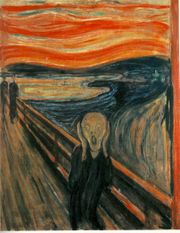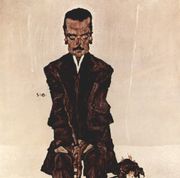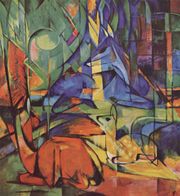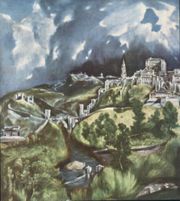Expressionism
2007 Schools Wikipedia Selection. Related subjects: Art
Expressionism is the tendency of an artist to distort reality for an emotional effect; it is a subjective art form. Expressionism is exhibited in many art forms, including painting, literature, film, architecture and music. Additionally, the term often implies emotional angst – the number of cheerful expressionist works is relatively small.
In this general sense, painters such as Matthias Grünewald and El Greco can be called expressionist, though in practice, the term is applied mainly to 20th century works.
Origin of the term
Although it is used as term to reference, there has never been a distinct movement that called itself expressionism, apart from the use of the term by Herwald Walden in his Polymic Magazine " Der Sturm" in 1912. The term is usually linked to paintings and graphic work in Germany at the turn of the century which challenged the academic traditions, particularly through Die Brücke and Der Blaue Reiter. Philosopher Friedrich Nietzsche played a key role in originating modern expressionism by clarifying and serving as a conduit for previously neglected currents in ancient art.
In The Birth of Tragedy Nietzsche presented his theory of the ancient dualism between two types of aesthetic experience, namely the Apollonian and the Dionysian; a dualism between a world of the mind, of order, of regularity and polishedness and a world of intoxication, chaos, ecstasy. The Apollonian represented the rationally conceived ideal, whereas the Dionysian represented artistic conception proper, originating from man's subconscious. The analogy with the world of the Greek gods typifies the relationship between these extremes: two godsons, incompatible and yet inseparable. According to Nietzsche, both elements are present in any work of art. The basic characteristics of expressionism are Dionysian: bold colors, distorted forms, painted in a careless manner, two-dimensional, without perspective, and based on feelings (the child) rather than rational thought (the adult).
More generally it refers to art that is expressive of intense emotion. It is arguable that all artists are expressive but there is a long line of art production in which heavy emphasis is placed on communication through emotion. Such art often occurs during time of social upheaval, and through the tradition of graphic art there is a powerful and moving record of chaos in Europe from the 15th century on: the Protestant Reformation, Peasants' War, Spanish Occupation of Netherlands, the rape, pillage and disaster associated with countless periods of chaos and oppression are presented in the documents of the printmaker. Often the work is unimpressive aesthetically, but almost without exception has the capacity to move the viewer to strong emotions with the drama and often horror of the scenes depicted.
The term was also coined by Czech art historian Antonín Matějček in 1910 as the opposite of impressionism: "An Expressionist wishes, above all, to express himself....[An Expressionist rejects] immediate perception and builds on more complex psychic structures....Impressions and mental images that pass through mental peoples soul as through a filter which rids them of all substantial accretions to produce their clear essence [...and] are assimilated and condense into more general forms, into types, which he transcribes through simple short-hand formulae and symbols." (Gordon, 1987)
Visual artists
Some of the movement's leading visual artists in the early 20th century were:
- Germany: Heinrich Campendonk, Emil Nolde, Rolf Nesch, Franz Marc, Ernst Barlach, Wilhelm Lehmbruck, Erich Heckel, Otto Dix, Karl Schmidt-Rottluff, Ernst Ludwig Kirchner, Max Beckmann, Conrad Felixmüller, Carl Hofer, August Macke, Elfriede Lohse-Wächtler, Ludwig Meidner, Paula Modersohn-Becker, Gabriele Münter, Max Pechstein and Käthe Schmidt Kollwitz .
- Austria: Egon Schiele and Oskar Kokoschka
- Russia: Wassily Kandinsky and Alexei Jawlensky
- Netherlands: Charles Eyck, Willem Hofhuizen, Jaap Min, Jan Sluyters, Vincent Van Gogh, Jan Wiegers and Hendrik Werkman
- Belgium: Constant Permeke, Gust De Smet, Frits Van den Berghe, James Ensor, Floris Jespers and Albert Droesbeke.
- France: Georges Rouault, Gen Paul and Chaim Soutine
- Norway: Edvard Munch, Kai Fjell
- Switzerland: Carl Eugen Keel
- Portugal: Mário Eloy
Expressionist groups in painting
There was never a group of artists that called themselves Expressionists. The movement is primarily German and Austrian, though American artists of the late 20th and early 21st Century have developed distinct movements that are generally considered part of Expressionism.
There were a number of Expressionist groups in painting, including the Blaue Reiter and Die Brücke. Later in the 20th century, the movement influenced a large number of other artists, including the so-called abstract expressionists, the latter consisting primarily of American artists such as Jackson Pollock. At the tale end of the 20th century, a group of artists in the American South developed a style known as Southern expressionism.
The group Der Blaue Reiter was based in Munich and Die Brücke was based originally in Dresden (although some later moved to Berlin). Die Brücke was active for a longer period than Der blaue Reiter which was only truly together for a year (1912). The expressionists had many influences, among them Munch, Vincent van Gogh, and African art. They also came to know the work being done by the Fauves in Paris.
Influenced by the Fauves, Expressionism worked with arbitrary colors as well as jarring compositions. In reaction and opposition to French Impressionism which focused on rendering the sheer visual appearance of objects, Expressionist artists sought to capture emotions and subjective interpretations: It was not important to reproduce an aesthetically pleasing impression of the artistic subject matter; the Expressonists focused on capturing vivid emotional reactions through powerful colors and dynamic compositions instead.
The "head" of Der Blaue Reiter, Kandinsky, would take this a step further. He believed that with simple colors and shapes the spectator could perceive the moods and feelings in the paintings, therefore he made the important jump to Abstraction, changing 20th century art.




